Lew Johnston – Perfecting the Wing-T Fullback Trap

This is a guest post from one of the Wing-T gurus, and an important mentor of mine, Lew Johnston.
To quote one of the Founding Fathers of the Delaware Wing T offense, Coach Tubby Raymond, “The Wing T is more than a formation. It is a system of offense. It is best described as a 4-back formation that originates as a running offense.” That sums up why this offense has been popular (and successful) for so long.
Another key facet of the Wing T is that it’s best described as ‘sequence football.” This should not be interpreted as meaning that every play is run in order, but rather that the offense is run in series where several points of attack are seemingly threatened as the ball is snapped.
Whether you’re talking “Old School” Delaware Wing T or the newly branded Hybrid Wing T, one of the basics of this system of offense is the 20 series (University of Delaware nomenclature.) Three plays dominate this series:
- Fullback Trap
- HB Buck Sweep
- QB Waggle (bootleg)
You can view old University of Delaware game film or, you can watch Auburn, Clemson or Texas Tech on TV next season and you will see these plays being run. The foundational play for this series, though, is Fullback Trap. Many Wing T coaches have told me that Trap is what they build their whole offense around. They are going to make defenses defend Trap first. Once Trap is established, the sequence offense begins to be exploited. I am going to explore the many facets of the Fullback Trap and show how you can perfect the Fullback Trap where it becomes a point of emphasis in your offense--- whether you run a version of the Wing T or you’re an I formation or Spread attack.
The focus of this article is on perfecting the Wing T Fullback Trap. However, before we discuss how to “perfect,” we need to introduce the play and give the basic rules. Once we have those established, we’ll proceed to techniques and coaching points to perfect the play.
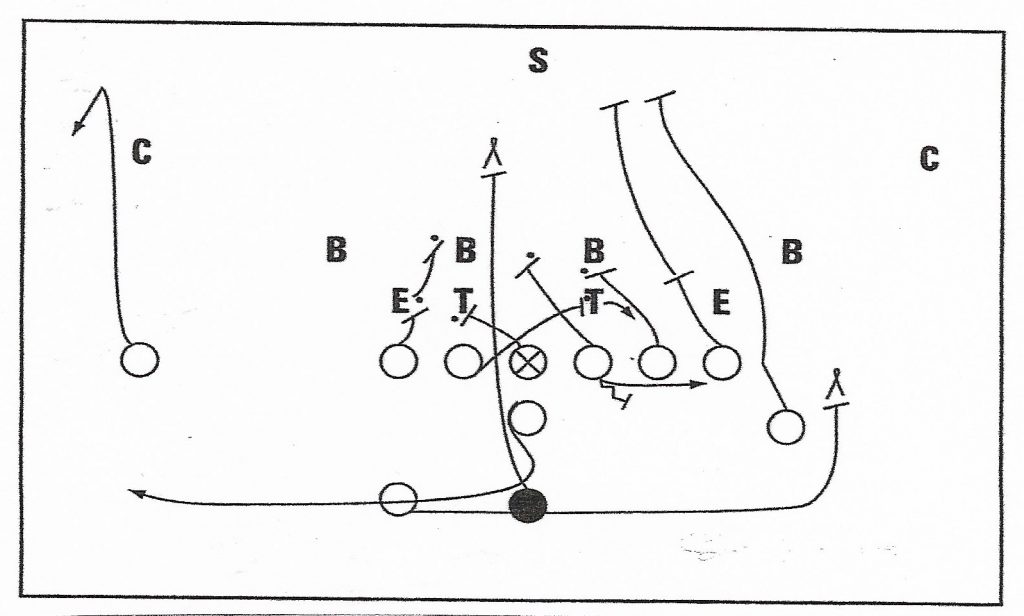
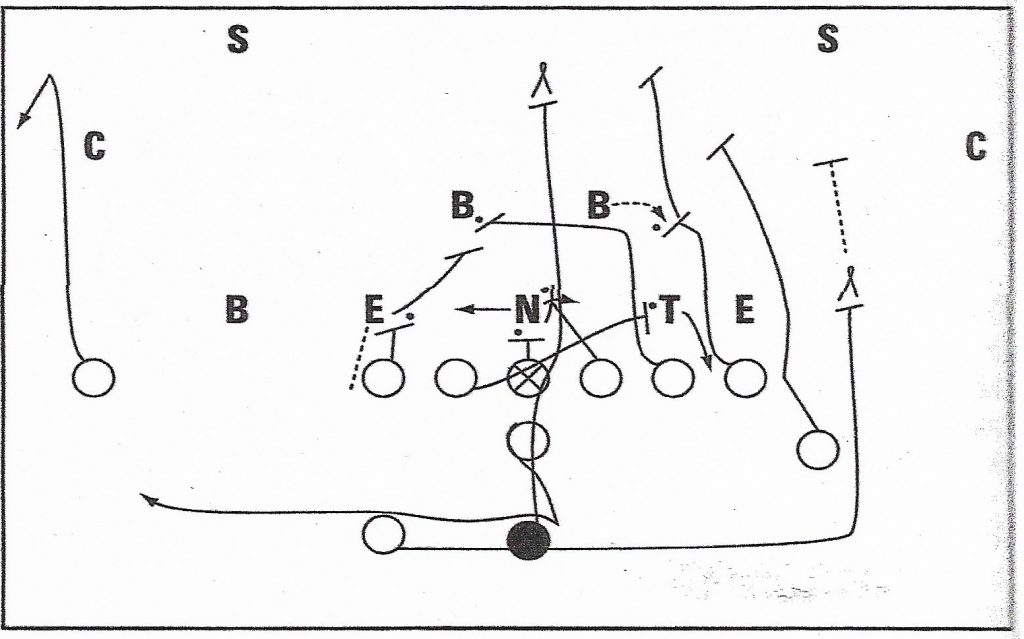
Rules
- TE: Gap- LB
- P-S T: 1st LB from Center
- P-S G: Gap – double Nose – backside LB – influence
- C: On – Away
- B-S G: Pull; Trap 1st man past Center
- B-S T: Gap – LB
- SE: Cut off F/S
- WB: LB to near Safety
- HB: Fake Buck Sweep
- QB: Reverse pivot; Handoff to Fullback; Fake to HB; Boot
- FB: Ball carrier: Dive for back-side foot of Center
Alternatives
One of the reasons that this play is so effective is that, regardless of the defense put up against you, there is a solution to counteract it. Thus, you can still run this Trap rather than being forced to go to another play in your playbook. The only defensive alignment that precludes you from running the Fullback Trap is if the defense chooses to put both defensive tackles on the inside shoulders to the A gaps on both Guards. At that point, one would use Woody Hayes’ old adage: “Don’t attack walled cities” and realize that by putting both Defensive Tackles inside of our Guards, they have made them susceptible to B and C gap plays.
The alternative schemes (or what I prefer to teach our offensive linemen as “calls”) are as follows:
- INFLUENCE: P-S guard can “false” pull outside (looks like buck sweep) if LB is reading guard or DT aligns inside of our guard.
- GUT: P-S guard influence pulls outside. B-S guard pulls and wraps around center to block LB in hole. Note: P-S DT is unblocked. “Gut” is effective when DT’s are “chasing” pulling guards.
- ON or WEDGE: Vs. an odd (50) front, it may be more effective to make an “on” or “wedge” call. The line fire blocks the man over them and the fullback looks for a crease.
- DOWN: Vs. a double eagle or Bears “46” where the center and both guards are covered, the center makes a “down” call to the play-side guard. the center then blocks “away” to the back-side 3 tech and the play-side guard blocks down on the nose.
These “calls” or alternative “schemes” are the first step to perfecting the Wing T Fullback Trap. For the play to be effective, offenses must be able to take advantage of what the defense gives them. This is one of the first principles of attacking defenses in the Delaware Wing T offense!
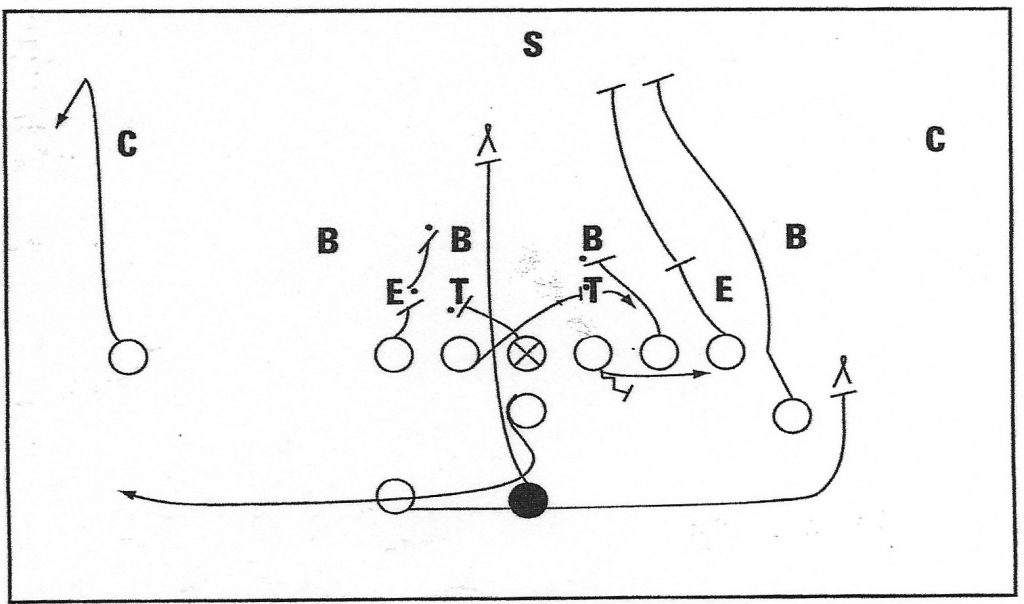
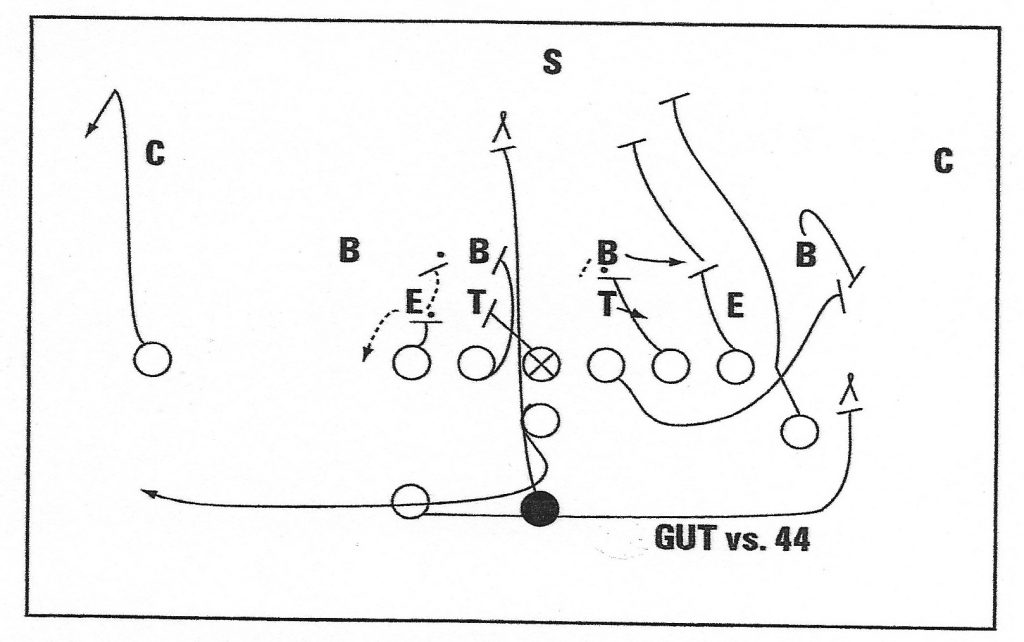
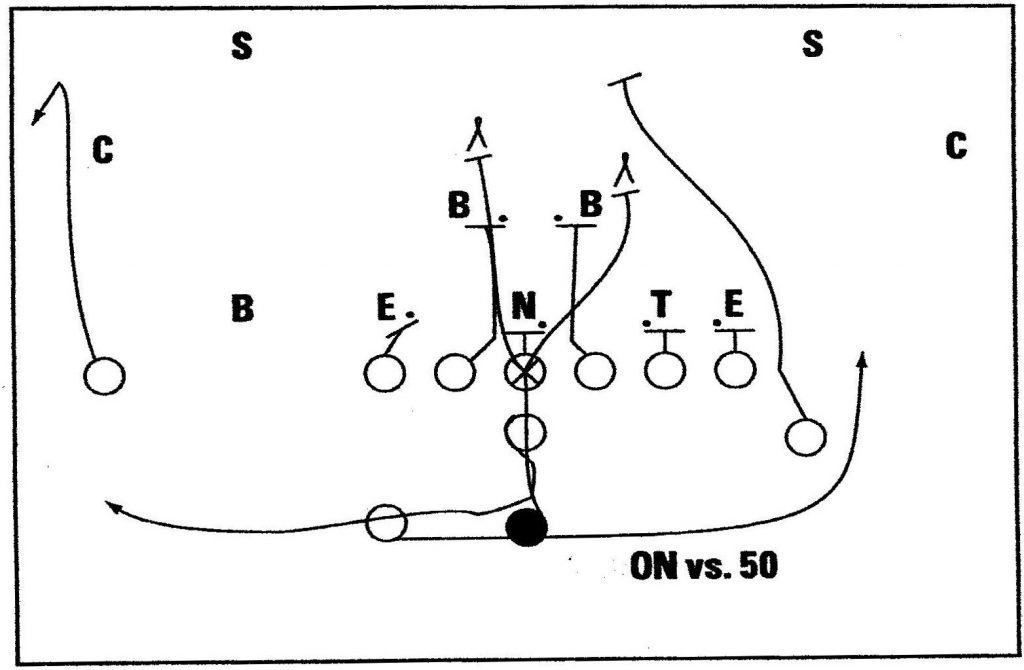
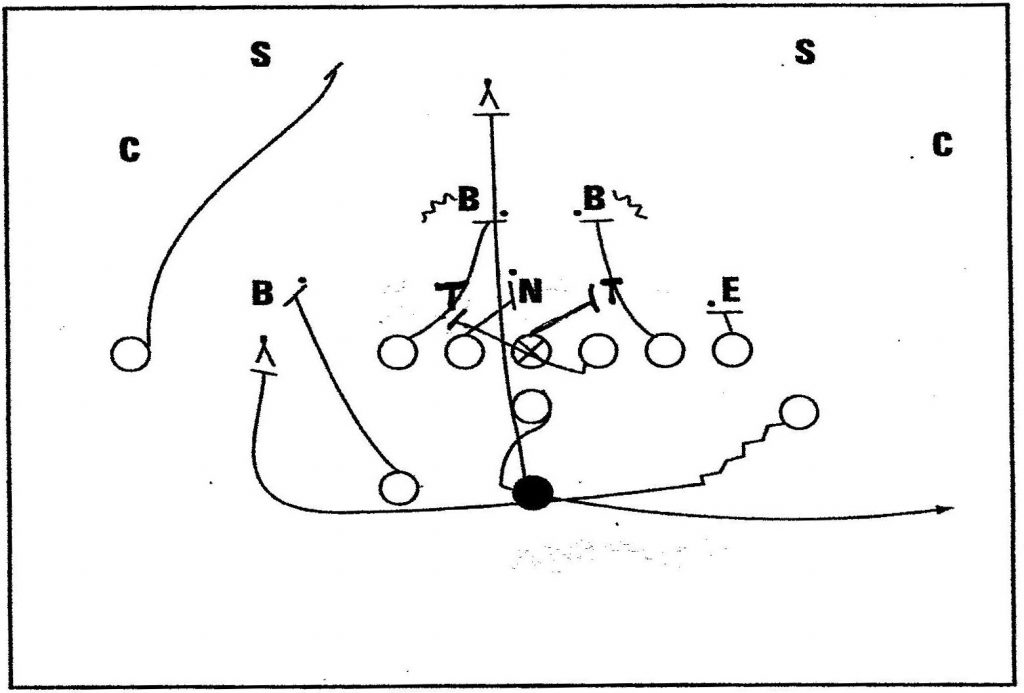
I need to point out that Fullback Trap to the weak-side (SE-side) is an effective play also. If you are going to give your Quarterback the option of “checking” to the 3 tech, your players must understand that the Trap can be run to that weak side also. When defenses “over-shift” and bring the DT down “on” our Center and have a 3 tech outside of our weak-side Guard, Trap to the SE side is wide open! Note that the rules don’t change up front. The only difference is that now the Wing is the back who fakes Buck Sweep and the Slot/HB’s rule is: LB to Near Safety.
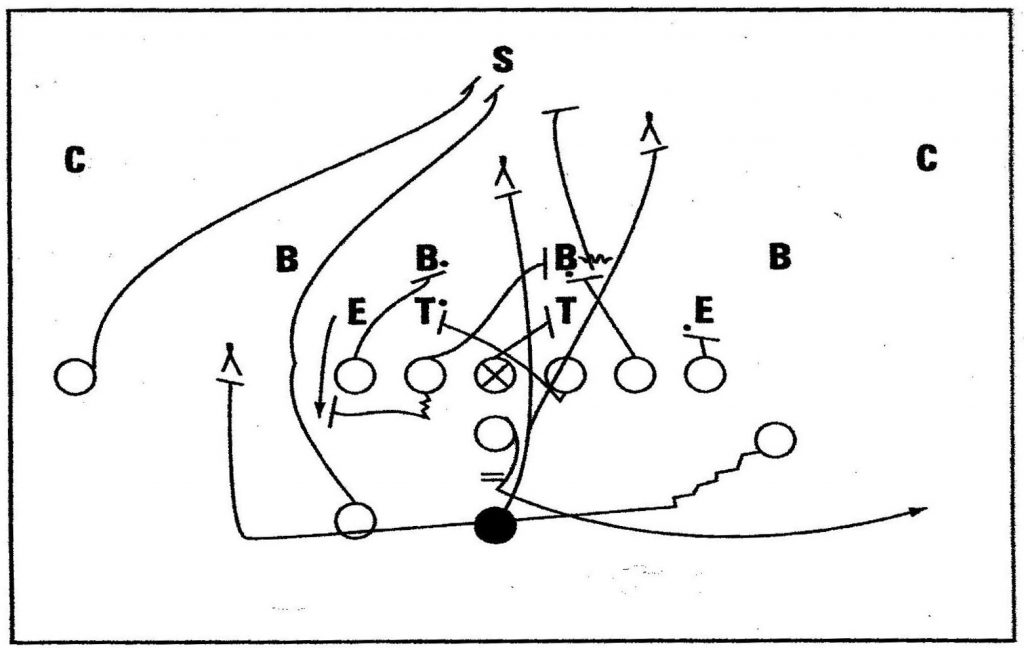
Employing the wall concept
I also have utilized another blocking scheme (“technique” might be a better term) which has proven to be very effective. This unusual concept of how to block the defense when running Trap is different from the “Tubby Raymond” concept; in that, rather than teaching intricate blocking rules for each player, it is what I refer to as the “Wall Concept.” I first had it explained to me by a long-time (and very successful) Wing T coach at Pulaski County HS in Southwest Virginia named Joel Hicks. I recently heard Rick Stewart of “Pistol Wing T” fame utilize it in his Pistol Wing T offense too.
This “Wall Concept” of blocking Fullback Trap simply teaches the play-side blockers: Guard, Tackle, Tight End (or Slot) to “build a wall” as they block “down” to their inside. The 3 play-side blockers work to get hip-to-hip and pin the linebackers inside the wall of blockers coming down at them. You teach the Fullback to receive the handoff, make a cut off of the trap block on the line of scrimmage and then “find the wall!” He is coached to cut to the right on trap right so he picks up the wall built by the right Guard, right Tackle and Tight End. It’s the blockers’ job to not allow any “leakage” as the Fullback cuts in behind them. This scheme has proven to be effective--- mostly because of its simplicity. There are no “rules” per se; just drive inside. The back-side Tackle’s rule doesn’t change. He too drives to get to the nearest Linebacker as quickly as possible.

Key coaching points to perfect the Fullback Trap
It should be noted that this is an inside running play. The basic rule for the pulling Guard that will be the “Trapper” is: “Kick out the 1st man past the Center.” The widest this play would ever go is if you’re facing a 5-2 defense. Then the “1st man” past the Center is likely to be the Odd front DT who’s aligned on our Offensive Tackle. Even then, the rules don’t change. The QB and Fullback, however, have to adjust their steps and path so the Fullback can make that “sharper” cut to the playside.
This is a quick-hitting play
The faster, the better! Though in the “old school” Wing T playbooks, the Fullback stood up in a 2-point stance, I recommend that if you’re going to make Trap an integral part of your offense you should put your Fullback down in a 2-point stance. He hits the line a lot quicker out of a 2-point stance.
It should be noted that one of my coaching mentors, Dr. Lee Fowler of Indian River HS in Chesapeake, VA (alma mater of Alonzo Mourning!), instructed me to “move up” your Fullback till he’s almost “sniffing the QB’s butt!” Dr. Fowler would work a pre-practice drill with the Centers, Guards, QB and Fullbacks where they would run Trap as many times as they could before practice started. However, with each rep, the linemen holding the big blocking dummies would squeeze the bags tighter and tighter on the Guards and the Fullback running the drill would inch up in his alignment with each rep. The idea was to get the Guard’s to race to their blocking point; the QB to get turned quickly; and the Fullback to try and beat the pulling Guard to the hole! It became quite competitive and was extremely helpful in teaching the key inside blockers to be explosive.
I might add that this is why I don’t like the Fullback (inside) Trap play unless the Fullback is no more than 4 yards from the ball in his alignment. This precludes, in my opinion, running it from a Pistol formation and some Shotgun formations. The Fullback is simply too deep to make this a quick-hitting play. Another potential problem is that we are NOT going to block the Defensive Ends. If the handoff takes too long, a fast End who’s closing quickly can hit your Fullback in the backfield.
The Fullback’s 1st step is the key to the timing
The relationship between the Offensive line, when their blocks actually take place and when the Fullback (any of the running backs) in the Wing T hits the hole is often underappreciated or simply overlooked by coaches. This is what makes the Wing T offense so devastating but, at the same time, if the relationship between blockers and running back is “off,” the play is likely to break down.
The Fullback’s 1st step is with his play-side foot. If it’s Trap right, his first step is with his right foot. This means that on his second step, he is receiving the ball and plants off of that foot (in this case, his left foot) and makes an explosive cut into the hole behind his pulling Guard (trapper.) This means that the Fullback is cutting off the “correct” foot.
The Fullback’s landmark on that first step varies according to the defensive front. He listens for a call from the Center: “Even” or “Nose” to tell him where his landmark is. If the call is “Even,” that means the hole is directly over the center. The Fullback’s first step is at the left heel of the Center. He then leads with his next step (left foot) directly ahead so the second step is at the left heel of the Center also. If the call is “Nose” it means it’s an Odd front defense. The Fullback adjusts his first step so it’s directly at the Center’s tail. His second step is something of a cross over step so he can get the proper cutting angle since the trap will likely be wider vs. an Odd front.
The QB’s steps come into play here also. In Lee Fowler’s playbook on Fullback Trap, he simply tells the QB: “Get out of the way!” The Fullback is getting the ball on the midline and he needs room to work. So the QB needs to get back quickly from the line pivoting on his play-side foot. In this case, running Trap right, the QB pivots on his right foot and turns his back away from the hole or play-side. He needs to stomach the ball and “punch” it quickly into the Fullback’s pocket as he comes by. He then continues to step back away from the line and fakes Buck Sweep and then carries out his Waggle fake away from the play till he’s outside the “tackle box.” This means that, for the defense, all 3 plays from the 20 series (some call it the “Buck Sweep” Series) look identical to each other. All of this faking forces the Linebackers to hesitate while they try to find the ball. That’s the step a quick-hitting Fullback needs to break the Trap.
A Wing T Fullback is not an I formation blocking back nor is he a converted pulling guard!
The Wing T Fullback is often deemed the “money back” in the Wing T offense. Veteran Wing T coaches tell me that the three best plays in the Wing T offense are the Trap, the Belly and the Down. Interestingly, the Fullback runs all three! Find a quick, strong, smart back who can read blocks and make quick changes of direction and put him at Fullback… IF you want to perfect your Fullback Trap.
Back your line off the ball
Like all Delaware Wing T offensive lines, your line should be “backed off” the ball as deep as they can be and not get called for illegal formation (not enough men ON the line!) We tell our Guards to put your helmet on the Center’s hip. The Tackles align on the Guards. We want them backed off the ball so that when they pull, they can attack the defense rather than having to give ground.
A key coaching point for your pulling Guard on Trap is: “Step on the Center’s ankle” as you pull. This forces the Center to move quickly to his (back) block and gets the pulling Guard up into the hole at top speed. We spend a lot of time on teaching this pulling angle to our Guards.
Get to the Linebackers
One of our mantras when running Trap is to emphasize to our linemen that “this play breaks when we get people on the Linebackers!" The more bodies (literally) “getting in the way” of linebackers makes this play great. *This is why I’m an advocate of the Wall Concept for play-side blockers on this play.
We teach our Tackles to 1- gap step hard to your inside first (to shut off potential penetration) and then “Go where he’s going to be…” NOT “where he is!” Good linebackers are not going to stand still. When they see the Fullback “bucking” into the middle of the line, they are likely to step up to meet him. Thus, our tackles are taught to “scrape paint” off the tails of the defensive linemen so they can “get in the way” of the near linebacker. Another point of emphasis here is: the tackles don’t need to make knock down blocks on the linebackers. Just simply, get their attention or get in their way! It’s the Fullback’s job to make his proper cut off of your block.
I like to put the Tight End on the near LB too
The more bodies on linebackers, the better off we are. However, they are coaches who prefer to send the TE to the near Safety. If/when the Fullback breaks, the Safety is occupied too and the chance for a long run goes up. In the Wing T, we have that “4th Man” on/near the LOS in the person of the Wingback. That is why we put the TE on the near Linebacker and send our Wing to the Safety. In the Wall Concept, the TE is the “top” of the wall. On Trap Right, he’s working to get on the upfield/right hip of the adjacent Tackle… to form that wall. This means that the TE is often the blocking who picks off the back-side pursuit (LB or S/S) coming across. It’s another aspect of the play when I have learned that Little Things Can Make a BIG Difference!
Kick out the 1st man past the Center
The pulling Guard’s rule on trapping is: Kick out the 1st man past the Center. You need to spend time showing your Guards any number of different scenarios so they can react to sudden changes. Perhaps, the biggest “surprise” is when the defense gets a LB through the line and into our backfield and he is now the “1st man past the Center!” Yes, we will trap a blitzing LB. We don’t want to change our rules/concepts. Our rules take care of every situation. But, these different situations must be practiced so the OL can “see” them and form a muscle-memory pattern. We do not want surprises on game night!
Trap the 3 Tech
The basic rule of thumb for Fullback Trap is: “Trap the 3 Tech; i.e., the DT outside the Offensive Guard. We’ll even block a DT who is “head up” on our Guard but we want the QB to “find” the 3 Tech and call the Trap to that side. This brings up an interesting scenario. The QB is responsible, on the line of scrimmage, to “audible” the play! Some coaches would balk at giving their QB this responsibility. Again, our experience has been, if you show the QB enough times in practice what it is you want him to “see”… he’ll make the right call. It’s all in the “sales pitch.” We sell it to our QB’s that: “You get to be Tom Brady or Russell Wilson! We’re going to let you check to the play we want AT the line! Do you think you can do that, Johnny?!” If the kid says “no,” then you have the wrong player at QB! You work with him and with enough reps, it is an easy read and call.
Things are Tough for the Play-side Guard!
The play-side Guard probably has the most difficult situation on this intricate play. It is why some Wing T coaches only trap right or… flip their line. The problem with this is: what if the Trap is called and the 3 Tech that you want to run it to is on the “wrong” side??!! We have always had a left side and right side Guard and Tackle. The Tight End is the only lineman who “flips” according to the formation called.
Note: In a drill that will be presented in the next section, it will be pointed out that all offensive linemen learn how to pull so every Offensive lineman has experience in pulling and trapping.
The play-side Guard’s rule is: Gap- Double with Center (on a Nose Tackle)- to Back-side LB… or Influence pull outside. Wow!! Lengthy and complex. A LOT to think about for that play-side Guard. My “Trap Guru,” Lee Fowler, came to our rescue with a simple concept that he used effectively for years and made his team’s Fullback Trap the most feared play in our District. He taught his play-side Guard this: IF the DT is “inside” of you--- (influence) pull to the outside and hit the defensive End. If the DT is “outside” you or “on” you, block inside. And “find work!” Go find an unblocked defender and get in his way. This lends itself to the “Wall Concept” of blocking Fullback Trap.
Dr. Fowler would also have his Center make an “Even” or “Nose” call. This helped identify for the pulling Guard who he is likely to block once he gets past the Center.
Keep Interior Splits Consistent
I talk to Wing T coaches who like to vary their line splits (move the Guard’s wider when running Trap) and others who want their linemen to stay consistent. I prefer keeping the interior splits (Center to Guards and Guards to Tackles) the same on all plays. This helps the pulling lineman to stay on the proper path and the ball carrier to stay “in relationship” with his key blocker. We will widen the Tight End’s split vs. an Even front DE but his split is not cogent to the inside Trap play.
Running Against the Split 6
I’ve been asked the question: What do you do if the defense comes out in the old “Split 6” with 2 3-Tech’s? We’d either run Tackle Trap Counter vs. that front or the Center tells the back-side Tackle “Charlie.” C for “cut.” Now the back-side Tackle will down block inside and cut off the 3 Tech so he cannot penetrate. It’s one less blocker on the Linebacker but where that Inside LB is aligned in a Split 4 or 6 defense, the Center has a clean shot at him to “pin” him to the back-side.
Running Against the Double Eagle
Attacking a Double Eagle (or Bear’s 46) front was discussed in the “Alternative” section of this article. To reiterate, the Center makes a “Down” call to the play-side Guard who blocks “down” on the Nose. The Center goes back-side to the 3 Tech. This means that the play-side Guard cannot get to the back-side LB to “pin” him but, in these defensive fronts, the Linebackers usually widen in their alignment which means, IF the Fullback hits the hole as fast as we want him to, that LB will be too far outside to get a shot at him. It’s the play-side Tackle’s job to block the Middle LB.
Practicing to perfect the Fullback Trap
I want to conclude this article by sharing some of the practice drills that we use to perfect the Fullback Trap. They are all “tried and true” and have proven to be effective in teaching your line (and your backs) how to perfect the Wing T Fullback Trap.
Bird Dog Drill
Our O line coach spends a few minutes each day during preseason practice perfecting our linemen’s first step. If the first step isn’t correct, everything that follows is only going to get worse! So, he puts the O linemen around him in a square or circle and works on them taking their first step--- and freezing! Thus, the idea of a hunting dog “freezing” when he spots a bird is where this term originates. The coach checks everybody’s first step on that particular blocking technique (in this case, for Trap, it might be the “Trap” technique. He resets everyone and they step left (the other direction) using the Trap step. Once he’s satisfied with the Trap step, he would move on to another block; i.e., Down or Reach. This can be a pre-practice drill that can be completed in 7 minutes.
“Stay On Your Path” Drill
Our O line coach is teaching the proper angle to take once the lineman has mastered the “Bird Dog” drill steps. This is what I call the Bird Walk drill. He sets up one complete O line, including the Tight End, on a yard line. He lays shields or cones to denote where the defenders would be. He puts a second line behind them 5 yards away with the cones set up there too. The same thing if you have enough bodies for a partial or full 3rd line.
He calls out the blocking technique and/or the play once the play is installed and calls out our cadence. Everyone takes that 1st step and freezes. The coach checks and if satisfied then says: “Ready… 2!” And everyone takes their 2nd step. The coach checks to be sure that everyone is heading in the right direction (they are “frozen” here too) and then calls out: “Ready… 3!” Then 4, 5, and 6 to have everyone stomp their way in the direction of their block. This is super slow speed (like putting the video clicker on “pause” and then moving it forward one frame at a time. It slows everything down for the coach and the players. It gives them a clear picture of what they will see once things get to game/practice speed.
The angle that the pulling Guard takes is important. I talked before about his landmark is the ankle of the Center. Run right through. Some guards want to hesitate to let the Center get out of the way. You must break them of that error quickly! If the center is too slow, it’s his fault. Once he gets his heel stepped on once or twice, he’ll move a lot faster.
Installation Drill
We use the “whole-part-whole” principle when introducing a new play. Trap is the first play we install in the summer. We put a full 11 out on the line and then bring out the backups behind them. I don’t spend a lot of time “teaching” rules here. This is just a preview. I want everyone to see what the play basically “looks” like. I have each player step through his assignment on Trap Right.
Note: Everything I’ve discussed has been running Trap Right. I did point out that the Fullback Trap can be run to the Split End-side too. Thus, Trap Left (with the TE to the offense’s left) can be just as easily called if you “flip” the strength.
We then break into Groups for “true” installation purposes. The O Line plus Tight Ends head out and the full backfield comes together. The SE’s go with the Receiver coach who instructs on their block on Trap. This Installation period begins with a Bird Dog drill for the backs as well as the line. Then we proceed to the “Stay On Your Path” or Bird Walk drill. Once I’m satisfied that everyone knows their assignment, then we run the Trap full speed. The first group gets one play to the right and one play to the left.
Note: We always set up a yard-line marker “hose” and (this is critical) lay down shields and/or bags to designate where the defenders would be. This comes into play particularly for the QB; because from the first time, the Trap is called, he needs to “identify” where the 3 Tech is! We make this very easy to “see” early on because we want our QB’s to have a lot of success early on.
I also have the backup Fullbacks stand in for the Center and Guards’ positions. It helps us to “see” landmarks and blocking while it also helps them to play the role of the O lineman who’s blocking for him. They go from offense (running the play) to lineman pulling. In some instances, they make a third rotation and stand over on defense, picking up a shield, to give the back who’s the play-side Guard a chance to go all the way to the back-side LB.
Once I’m satisfied that the players (particularly the starters) have a working knowledge of the play, we come back together and run the play a few times against bags. Explain to the scout defense that they are “living blocking bags” and nobody is to move. Once the offense has a firm grasp of what their rules are and the technique for carrying out that rule, we let the scout defense start moving around a little.
Note: I think it’s imperative to build confidence in your prospective starters early in the installation phase. We do not put defensive starters over on the scout team and we do not run a blitz unless the offense knows it’s coming. We’ll run Trap for 15-20 minutes each day during preseason and devote a period to it once a week during in-season. It is too intricate a play to forego reviewing it as often as possible.
“Find the Linebacker” Drill
While the Centers and Guards are working on the back block/cross (trap) block, you need a coach who can take the tackles and Tight Ends and work on “finding the linebackers.” Regardless of whether you install the play using the Delaware concepts or the “Wall” concept, your tackles need to understand that it is their block that will spring the fullback for the big gain. We must get on linebackers if this play is to work! The coach takes a left and right tackle and puts 2 backups on defense with shields. We bird walk first so the players can see in “slow motion” what’s happening in front of them. As they get the picture, he starts speeding it up. We lay some Big Bertha bags as defensive linemen so the tackles involved in the play have to “scrape paint” to get to where the linebacker is going to be… NOT, where he is when the play starts. A reminder here that a big block is not necessary. If the tackle and/or tight end can merely “distract” the linebacker (our kids like to say: “get in his way!), the Fullback will do the rest. The play hits so fast that if the Tackle/Tight End can cause the linebacker to look at him, the fullback is past them! But, we must get him to the second level.
(Inside) Trap Drill
This is taken directly from the University of Delaware playbook. Every time our staff visited Delaware for their Coaches Clinic, the Offensive Line coach always demonstrated this drill. Not only would he diagram it but he brought his linemen in to show us how to run the drill.
Note: If you are a Wing T coach and you don’t have 8-12 “Big Bertha Bags” for blocking purposes, you need to find the money to purchase them. These bags are 110 pounds and are perfect for teaching Wing T blocking techniques.
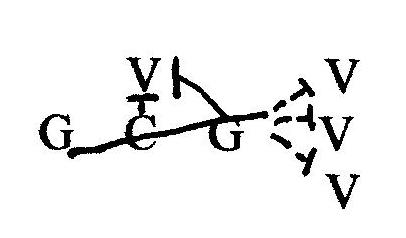
The short trap drill is used to perfect the double team on a Nose by the Center and play-side Guard and/or the back block by the Center (vs. an Even front) and the “climb” block by the play-side Guard to the back-side linebacker. Dummies are set up where potential defenders would be aligned and everyone takes a rep at being the guards (pulling and down blocking.) Place 3 potential “trap men” on defense. On the snap, one of them stands up. That is the D lineman that the puller will kick out.
Gut Drill
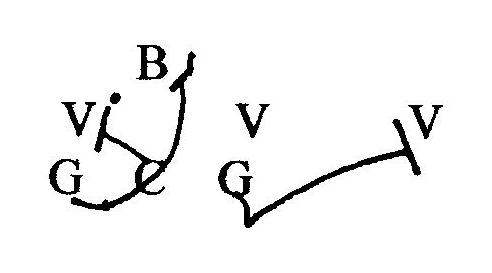
The “gut” drill is used to teach a lineman to pull through the hole (as opposed to trapping on the line) to block a linebacker. Three bags are used to designate the defenders. The play-side Guard pulls outside (influence pull) and is a false key. The Center back blocks the bag representing the DT and the back-side puller goes behind the Center and turns up through the hole and blocks the linebacker. He gets his head to the attack side – blocking him with his backside shoulder and working his hips to “pin” him inside.
Squeeze Drill
This drill was briefly described earlier. You bring your center’s, guards, quarterbacks and fullbacks together in your pre-practice period. You also need 2 blocking bags. The coach stands behind the fullback and directs the bag holders where to align. The center and QB make their call; the ball is snapped and the Fullback explodes into the hole. The O linemen and QB stay while another Fullback lines up. The coach directs the alignment of the bags, the calls are made and the play is run again. Keep going rapid fire so that everyone is getting reps. The aspect of this drill that makes it so interesting is that as the drill proceeds, the coach directs the bag holders to start “squeezing” down their split. They will eventually get so tight that a “check” needs to be made and an alternate blocking concept needs to be used. The drill is designed to get the guards moving fast and the fullback hitting the hole explosively. If the fullback runs into the pulling guard, that guard is moving too slowly. By squeezing the bags closer together, if forces the pulling guard to alter his angle so he can always get inside> out on the trap man. This drill can get competitive so the coach has to be careful to control things. It is done during pre-practice so nobody has fully stretched out. Be careful that nobody pulls a muscle trying to go too fast, too soon.
Conclusion
The Wing T Fullback Trap has been a staple of the offense since the “20 series” was first introduced in the early 1950’s. The trap does not require that you have a 225 pound bruiser at fullback. On the contrary, some of the best fullbacks to execute this play are small, tough and explosive runner.
There are several different blocking schemes that can (and should) be utilized to get the maximum benefit from this play. Because of this, perfecting this dynamic play is going to require constant repetitions… throughout the season. By following the blocking rules of Trap and the alternative “calls” that the line can make, you can block any type of defense your opponents throw up against you.
Once you have established the Fullback (inside) Trap, the rest of the series becomes that much more effective as defenses must hesitate to find the football. Everyone knows the old adage: “He who hesitates is lost!” Perfecting the Wing T Fullback Trap will force defenses to be lost. There’s no other play in football that electrifies the crowd than to see a fullback pop through the line and blaze his way down the field into the end zone.